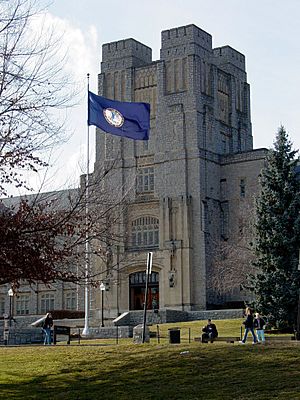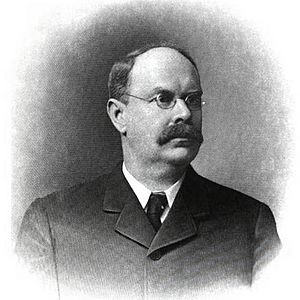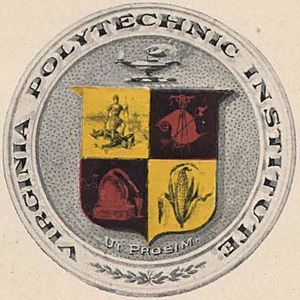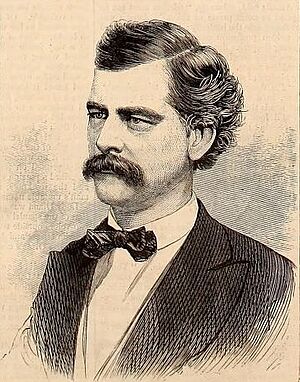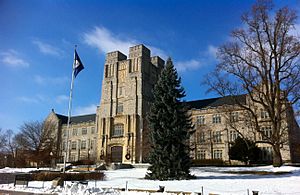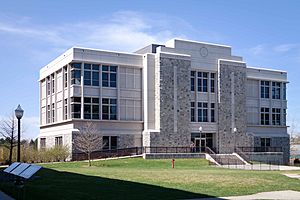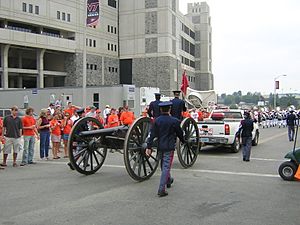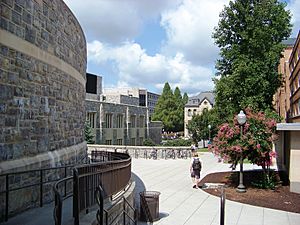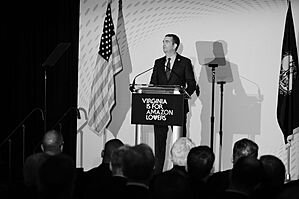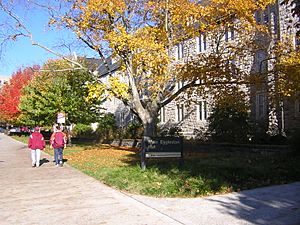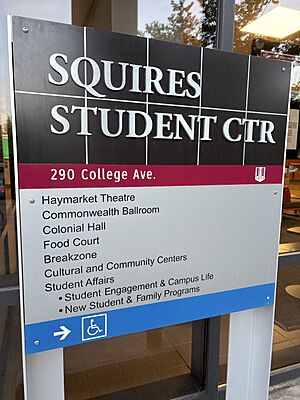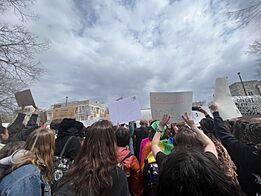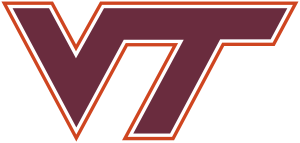Virginia Tech facts for kids
 |
|
|
Former names
|
Virginia Agricultural and Mechanical College (1872–1896) Virginia Agricultural and Mechanical College and Polytechnic Institute (1896–1944) Virginia Polytechnic Institute (1944–1970) |
|---|---|
| Motto | Ut Prosim (Latin) |
|
Motto in English
|
"That I May Serve" |
| Type | Public land-grant research senior military university |
| Established | June 20, 1872 |
| Accreditation | SACS |
|
Academic affiliations
|
|
| Endowment | $1.7 billion (2022) |
| Budget | $2.06 billion (2023) |
| President | Timothy D. Sands |
| Provost | Cyril Clarke |
|
Academic staff
|
1,395 |
| Students | 36,383 |
| Undergraduates | 29,300 |
| Postgraduates | 7,083 |
| Location |
,
,
United States
37°13.5′N 80°25.5′W / 37.2250°N 80.4250°W |
| Campus | Small city, 2,600 acres (11 km2; 4.1 sq mi) |
| Other campuses |
|
| Newspaper | Collegiate Times |
| Colors | Chicago maroon and burnt orange |
| Nickname | Hokies |
|
Sporting affiliations
|
NCAA Division I FBS – ACC |
| Mascot | HokieBird |
 |
|
The Virginia Polytechnic Institute and State University, often called Virginia Tech (VT), is a large public university. Its main campus is in Blacksburg, Virginia, United States. It started as the Virginia Agricultural and Mechanical College in 1872.
Virginia Tech also has learning centers in six other parts of Virginia. It has a research center in Punta Cana, Dominican Republic, and a study-abroad location in Riva San Vitale, Switzerland. Virginia Tech is also a senior military college through its Corps of Cadets program.
The university offers 280 different degree programs for its 37,000 students. In 2016, it was the second-largest public university in Virginia by student numbers. It is known for having "Very high research spending and doctorate production."
The university's sports teams are called the Virginia Tech Hokies. They compete in Division I of the NCAA as part of the Atlantic Coast Conference.
Contents
History of Virginia Tech
In 1872, the state of Virginia used money from the Morrill Act of 1862 to buy the buildings of a small school called Preston and Olin Institute. This school was in a rural area of Montgomery County. They also bought about 250 acres of land from a nearby farm. The state then opened a new school called Virginia Agricultural and Mechanical College. It was a state-supported military school.
Virginia Tech's first student, Addison "Add" Caldwell, signed up on October 1, 1872. He had walked over 25 miles from his home. A statue on campus remembers his journey. First-year cadets still re-enact part of his walk every year.
Early leaders of the college had ties to the Civil War. For example, the first Commandant, James H. Lane, was a former general. Lane Hall, an old building on campus, is named after him.
For many years, the Confederate Battle Flag was used at Virginia Tech sports events. The band also played the song "Dixie". In the late 1960s, a student named Marguerite Harper helped end these practices. She was a Black woman who was elected to the student senate. Her resolution to stop the flag display was successful, even though some people protested. The Confederate flag was also removed from class ring designs over time.
During World War I, the university started a Reserve Officer Training Corps (ROTC) program. This helped support the country's efforts in the war.
College Name Changes and Growth
The college changed its name several times as it grew. In 1896, it became Virginia Agricultural and Mechanical College and Polytechnic Institute. People often just called it "Polytechnic Institute." In 1944, the name was officially shortened to Virginia Polytechnic Institute (VPI).
VPI welcomed its first female students in 1921. They were day students and did not live on campus. In 1940, the first dorm for women, Hillcrest Hall, was built. In 1943, VPI joined with Radford State Teachers College, which became VPI's women's division. This merger ended in 1964. Today, Radford University is its own co-educational university.
Post–World War II Changes
In 1953, VPI became the first historically white public university in the South to admit a Black undergraduate student. Three more Black students were admitted in 1954. At that time, Virginia still had laws that separated people by race. These first Black students at VPI could not live in dorms or eat in dining halls on campus. They stayed with African American families in Blacksburg. In 1958, Charlie L. Yates was the first African American to graduate from VPI. He earned a degree in mechanical engineering with honors.
President T. Marshall Hahn led VPI from 1962 to 1974. He helped change VPI from a small military school into a major research university. The number of students grew a lot, and new buildings were constructed. More professors were hired, and research funding increased. In 1964, male students no longer had to join the Corps of Cadets for two years. In 1973, women were allowed to join the Corps, making Virginia Tech one of the first military colleges to include women.
In 1970, the state officially changed the university's name to Virginia Polytechnic Institute and State University. In the early 1990s, "Virginia Tech" became the official short name. Diplomas still use the full formal name.
21st Century Growth
The university has continued to grow in the 2000s. In 2001, Virginia Tech bought more land next to the campus, making the College Farm over 3,000 acres. The Virginia Tech Carilion School of Medicine and Research Institute was created in partnership with the Carilion Clinic. The university's graduate and business programs also grew quickly. In 2014, Virginia Tech spent over $500 million on research.
After the September 11 attacks, more students joined the Corps of Cadets. By 2018, there were 1,127 cadets, the most since the mid-1960s. The Corps plans to grow to 1,400 cadets in the future.
2007 Campus Tragedy
On April 16, 2007, a student caused a terrible tragedy on campus. Thirty-two faculty members and students were killed, and 17 others were hurt. This event was a very sad day for the Virginia Tech community.
Recent Campus Expansion
In 2019, Virginia Tech offered money to some new students to delay starting school for a year. This was because more freshmen than expected wanted to come. The university also allowed freshmen to live off-campus that year and used a hotel to house students.
University Organization
Virginia Tech is a public university and one of Virginia's two land-grant institutions. Its academic programs are managed by nine colleges, the Graduate School, and the Honors College.
| College/School | Year Founded |
|---|---|
| Graduate School | 1891 |
| College of Engineering | 1903 |
| College of Agriculture and Life Sciences | 1903 |
| College of Architecture, Art, and Design | 1964 |
| College of Liberal Arts and Human Sciences | 1964 |
| College of Science | 1964 |
| Pamplin College of Business | 1965 |
| College of Veterinary Medicine | 1978 |
| College of Natural Resources and Environment | 1992 |
| Carilion School of Medicine and Research Institute | 2007 |
| Honors College | 2016 |
University Leadership
The university is governed by a Board of Visitors. This board is in charge of the university's property and students. The first board was created in 1872 by Virginia Governor Gilbert C. Walker. Since Virginia Tech is a public university, 13 of the 14 board members are chosen by the Governor of Virginia. The 14th member is the president of the Virginia Department of Agriculture and Consumer Services. At least 6 board members must be Virginia Tech alumni, and at least 10 must live in Virginia.
Academics and Admissions
Virginia Tech offers many different degree programs. There are 116 bachelor's degree programs, 160 master's and doctoral programs, and a professional degree in veterinary medicine. The Virginia Tech Carilion School of Medicine and Research Institute is a partnership between Virginia Tech and the Carilion Clinic.
Becoming a Virginia Tech Student
| Number of freshman applicants | 32,103 |
| Admit rate | 73% |
| Participated in Early Decision Plan | 18% |
| Average GPA of admitted students | 4.15 |
| Average SAT scores of admitted students | 1310 |
| Middle 50% ACT scores of admitted students | 24 to 28 |
Virginia Tech receives many applications each year. For the fall 2015 freshman class, nearly 22,500 students applied. About 65.8% of applicants were offered admission. Students who were accepted usually had a high-school GPA of 4.00. Their average SAT score was 1250.
Virginia Tech has a special Honors College for students who want an extra challenge. Honors students can earn credits in 11 different ways. They need to keep a 3.6 GPA to stay in the program. About a quarter of the 1,600 Honors students live in special Honors dorms.
In 2023, Virginia Tech stopped using "legacy admissions." This means that having a family member who went to Virginia Tech no longer gives an applicant an advantage. The university also ended its binding early decision program. This was done to reduce pressure on students, especially those needing financial help.
University Rankings
Virginia Tech is recognized as a top university.
| Biological Sciences | 119 |
| Chemistry | 67 |
| Clinical Psychology | 71 |
| Computer Science | 35 |
| Earth Sciences | 33 |
| Economics | 68 |
| Education | 90 |
| Engineering | 31 |
| English | 80 |
| Mathematics | 51 |
| Physics | 50 |
| Psychology | 71 |
| Public Affairs | 56 |
| Public Health | 99 |
| Sociology | 76 |
| Statistics | 37 |
| Veterinary Medicine | 18 |
| Biological/Agricultural | 9 |
| Civil | 9 |
| Environmental/ Environmental Health | 4 |
| Industrial/Manufacturing/Systems | 7 |
In U.S. News & World Report's "2024 Best Colleges" list, Virginia Tech was tied for 47th among all national universities. It was tied for 20th among public universities. It also ranked 25th for "Most Innovative" schools.
The Pamplin College of Business's part-time MBA program was tied for 19th in 2020. The Master of Information Technology program, which is online, ranked 4th.
The Virginia Tech College of Architecture and Urban Studies (CAUS) has highly-ranked programs. In 2016, DesignIntelligence ranked its undergraduate architecture program 3rd nationally. Its graduate architecture program ranked 9th. The landscape architecture programs were ranked 2nd in the nation in 2013.
Kiplinger's Personal Finance placed Virginia Tech 20th in its 2019 list of best value public colleges.
Student Life Rankings
The Princeton Review gave Virginia Tech these rankings in its 2025 Best Colleges list:
| Category | Ranking |
|---|---|
| Best Alumni Network (Public Schools) | 2 |
| Their Students Love These Colleges | 5 |
| Best Career Placement (Public) | 8 |
| Best Student Support and Counseling Services | 8 |
| Best Campus Food | 10 |
| Best Schools for Making an Impact (Public) | 10 |
| Most Engaged in Community Service | 14 |
| Best Schools for Internships (Public) | 17 |
| Town-Gown Relations are Great | 17 |
| Best Value Colleges without Aid (Public) | 19 |
| Lots of Greek Life | 20 |
| Best Value Colleges (Public) | 39 |
Research at Virginia Tech
Virginia Tech spends a lot on research and development (R&D). In 2019, it spent $542 million, ranking 48th among all education institutions in the U.S. and 2nd in Virginia. This was the 15th year in a row that Virginia Tech's research spending grew. The university's research budget has more than doubled since 2000. Virginia Tech is in the top 5 percent of over 900 research universities. Each year, researchers get many awards to study topics like agriculture, biotechnology, and energy. This research has led to many new inventions and patents.
| 2009 | $399 million |
|---|---|
| 2011 | $450 million |
| 2013 | $496 million |
| 2015 | $504 million |
| 2017 | $522 million |
Fralin Life Science Institute
The Fralin Life Science Institute started in 2008. It focuses on research in areas like diseases spread by insects, plant sciences, and how living things interact with their environment.
The institute offers many chances for undergraduate students to do research. This includes programs for first-year students and summer research fellowships.
Virginia Tech Transportation Institute
The Virginia Tech Transportation Institute (VTTI) began in 1988. It has over 350 staff members. VTTI's goal is to make transportation safer, save time and money, and protect the environment. It is the second-largest university transportation institute in the U.S. and has the biggest group of driving safety researchers in the world.
VTTI has special facilities like the Virginia Smart Road, which is a 2.2-mile test road. They also have labs for working on vehicles and testing safety devices. VTTI's research helps create new transportation safety rules. They are known for their studies on distracted driving.
Institute for Critical Technology and Applied Science
Since 2005, the Institute for Critical Technology and Applied Science (ICTAS) has worked on projects that combine engineering, science, and other fields. Their focus areas include nuclear engineering, tiny technologies (nanoscale), and sustainable energy.
Other Research Areas
Virginia Tech also does research in many other areas. These include powerful computers, advanced materials, wireless communication, and human and animal health. They also study the environment and different types of energy, like fuel cells and solar power.
- The Virginia Tech - Wake Forest University School of Biomedical Engineering & Sciences works on topics like how the body moves (biomechanics) and how cells work.
- Virginia Tech Intellectual Properties Inc. (VTIP) helps protect and license inventions made by university researchers.
- The Virginia Tech Applied Research Corporation (VT-ARC) does research for government and private groups. They work on topics like cybersecurity and national security.
- The Virginia Cooperative Extension helps improve farming practices and life for people in Virginia.
- The Virginia Tech Corporate Research Center (VTCRC) is a park with over 170 research and technology companies. It employs over 2,900 people.
- The Virginia Tech Language and Culture Institute (LCI) helps people learn languages, especially English.
Virginia Tech Campus
The main Virginia Tech campus is in Blacksburg, Virginia. Most of the buildings are made of a special gray stone called Hokie Stone. This stone has shades of brown and pink. In 2010, the university decided that all new buildings should use Hokie Stone.
The center of campus is the Drillfield. This is a large oval field used by the Virginia Tech Corps of Cadets for military drills. Most academic buildings are on one side of the Drillfield, and student dorms and dining halls are on the other. Newman Library is on the east side and connects to Torgersen Bridge, which goes over Alumni Mall. The Upper Quad, also known as military campus, is north of the Drillfield. It has the Corps of Cadets' barracks.
Other Campuses
Virginia Tech has five other campuses in Virginia:
- Hampton Roads Centers in Newport News and Virginia Beach
- Northern Virginia Center in Falls Church
- Virginia Tech Richmond Center in Richmond
- Virginia Tech Roanoke Center in Roanoke
- Virginia Tech Southwest Center in Abingdon
Washington D.C. Area Campuses
Virginia Tech has a strong presence in the Washington Metropolitan Area. This includes graduate education and research programs. They work with government agencies, businesses, and other universities. Locations include Alexandria, Arlington, and Fairfax.
Innovation Campus
The Virginia Tech Innovation Campus is a new development in Alexandria, Virginia. It started in 2018. This campus offers graduate degrees in computer science and engineering. It focuses on new technologies like artificial intelligence and wireless networks.
The first main building, Innovation Campus Building One, was finished in February 2025. It is 11 stories tall. The total cost of the campus is expected to be $1 billion.
Important partners for the campus include the Commonwealth of Virginia, the City of Alexandria, Northrop Grumman, and Boeing. Virginia donated about $2 billion to support research at Virginia Tech and George Mason University. This helped Amazon decide to build its HQ2 headquarters nearby.
International Campuses
Caribbean Center for Education and Research (CCER)
The Caribbean Center for Education and Research (CCER) is in Punta Cana, Dominican Republic. It helps Virginia Tech professors and students study things like biodiversity and how to manage natural resources. The center works with the PUNTACANA Ecological Foundation, which protects a large forest and coral reef.
Steger Center for International Scholarship
The Steger Center is Virginia Tech's campus in Europe. It is in Riva San Vitale, Switzerland. This center supports Virginia Tech programs in the region and is close to cities like Milan.
Agricultural Research Centers
Virginia Tech has several agricultural research centers across Virginia. These centers help improve farming and the quality of life for people in the state. They include centers like Eastern Shore, Hampton Roads, and Shenandoah Valley.
Campus Power Plant
The university has its own power plant with a tall smokestack. This plant makes steam that heats many campus buildings and provides some electricity. Most buildings are connected to the plant by a network of tunnels.
Student Life at Virginia Tech
| Race and ethnicity | Total | ||
|---|---|---|---|
| White | 60% |
|
|
| Asian | 12% |
|
|
| Hispanic | 10% |
|
|
| Other | 8% |
|
|
| Foreign national | 4% |
|
|
| Black | 6% |
|
|
| Economic diversity | |||
| Low-income | 15% |
|
|
| Affluent | 85% |
|
|
There are over 700 student groups at Virginia Tech. Some groups include Bolt at Virginia Tech, which builds electric racing motorcycles, and PRISM, a student-run ad agency. Over 9,300 students live on campus.
Corps of Cadets
Until 1964, male students had to be part of the Virginia Tech Corps of Cadets for two years. Now, joining is voluntary. Students in the ROTC program must be part of the Corps. Virginia Tech is one of only three public universities in the U.S. with both a Corps of Cadets and regular civilian students.
More than 1,000 cadets live on campus in special dorms called "cadet barracks." These are in the Upper Quad, which has some of the oldest buildings. Two new dorms, Pearson Hall and New Brodie, were built recently for the cadets.
Fraternities and Sororities
Virginia Tech has many fraternities and sororities. These are social groups that students can join. About 20% of undergraduate students are part of a fraternity or sorority. Some of these groups have houses on campus in the Oak Lane Community. There are also other academic and service-related groups.
Clubs and Student Activities
Virginia Tech offers many clubs and activities. The university has about 800 official clubs. Students can find clubs to join on a website called Gobblerconnect. Every year, there is a "Gobblerfest" where clubs show what they do to new students.
Some notable student-led groups include the radio station WUVT-FM, the newspaper The Collegiate Times, and the literary magazine Silhouette.
Cultural and Community Centers
Virginia Tech has five cultural and community centers in the Squires Student Center. These are the Black Cultural Center, the Ati:Wa:Oki Indigenous Community Center, El Centro, the Pride Center, and the APIDA (Asian Pacific Islander Desi American)+ Center. These centers offer a safe and welcoming space for students. They provide educational resources and host events like speaker series and cultural celebrations.
In 2023, Virginia Tech was named an Asian American Native American Pacific Islander Serving Institution (AANAPISI). This means that about 12% of students identify as AANAPI. This designation helps the university get grants to support programs for these students.
Diversity, Equity, and Inclusion
As of March 2025, Virginia Tech closed its Office of Diversity, Equity, and Inclusion (DEI). This decision was made after a federal order asked all schools to remove DEI programs. This action caused some students to protest on campus.
Virginia Tech Athletics
Virginia Tech's sports teams are called the Hokies. The HokieBird is a turkey-like mascot. The word "Hokie" comes from an old school cheer.
The Hokies compete in Division I sports. They are part of the Atlantic Coast Conference (ACC) for all sports since 2004–05. Before that, they were in the Big East Conference and the Atlantic 10 Conference.
Men's sports include baseball, basketball, football, and soccer. Women's sports include basketball, field hockey, soccer, and softball.
Virginia Tech's fight song is "Tech Triumph". It was written in 1919 and is still played today. The student band, The Marching Virginians, and the Corps of Cadets' band, the Highty Tighties, play it at sports events.
The main sports facilities include Lane Stadium for football and Cassell Coliseum for basketball.
People of Virginia Tech
Faculty Members
Many notable people have taught at Virginia Tech. These include Nikki Giovanni (English), Marc Edwards (civil and environmental engineering), and Liviu Librescu (engineering science and mechanics).
Virginia Tech has had 17 university presidents since it started in 1872. The current president is Timothy Sands, who began in 2014.
| Virginia Tech Presidents | |
|---|---|
| Charles Landon Carter Minor | 1872–1879 |
| Charles Robert Scott Ship | 1880 |
| John Lee Buchanan | 1880–1881 |
| Thomas Nelson Conrad | 1882–1886 |
| Lunsford Lindsay Lomax | 1886–1891 |
| John McLaren McBryde | 1891–1907 |
| Paul Brandon Barringer | 1907–1913 |
| Joseph Dupuy Eggleston | 1913–1919 |
| Julian Ashby Burruss | 1919–1945 |
| John Redd Hutcheson | 1945–1947 |
| Walter Stephenson Newman | 1947–1962 |
| Thomas Marshall Hahn Jr. | 1962–1974 |
| William Edward Lavery | 1975–1987 |
| James Douglas McComas | 1988–1994 |
| Paul Ernest Torgersen | 1993–2000 |
| Charles William Steger | 2000–2014 |
| Timothy David Sands | 2014–present |
Famous Alumni
Virginia Tech has over 240,000 alumni (former students) around the world. The Virginia Tech Alumni Association is known as one of the best. Many alumni have received important scholarships like the Rhodes Scholarship and Fulbright Scholars.
Virginia Tech has trained many military leaders, including 97 generals and admirals. Eight alumni have received the Medal of Honor, the highest award for bravery in the U.S. military. Their names are carved on a monument on campus.
Many alumni have also held important roles in government. These include governors, ambassadors, and members of Congress.
Outside of public service, Virginia Tech alumni have made contributions in business, writing, music, and journalism. These include children's book author Kwame Alexander, jazz guitarist Charlie Byrd, and TV news anchor Hoda Kotb.
Famous Virginia Tech athletes include football coach Frank Beamer, basketball player Dell Curry, and football players Michael Vick and Bruce Smith.
Images for kids
See also
 In Spanish: Instituto Politécnico y Universidad Estatal de Virginia para niños
In Spanish: Instituto Politécnico y Universidad Estatal de Virginia para niños
- Fighting Gobblers
- Hahn Horticulture Garden
- List of forestry universities and colleges
- Virginia Tech commencement speakers


